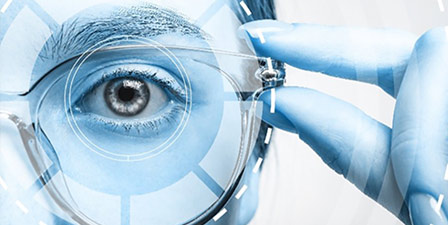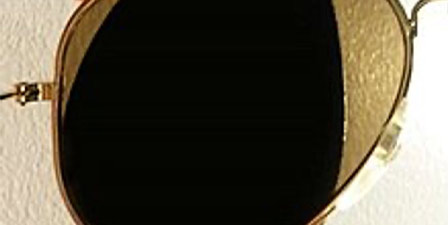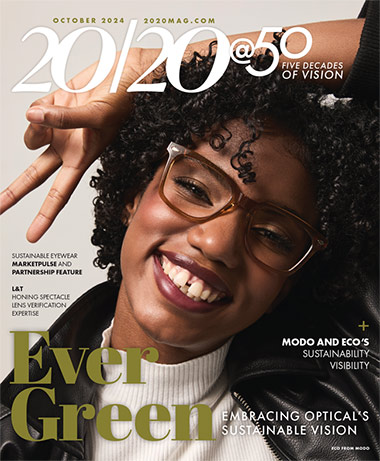
|
Variable Focus Technology is the way the Adlens eyewear, John Lennon, Hemisphere and Emergensee work. It makes it possible to change eyeglass lens power by self-adjustment. That's right; minus and/or plus lens power in these glasses is not fixed, until the wearer chooses it. When do eyeglass wearers choose their own power? The answer is many, many times everyday but optical offices are a very small part of it.
On average, in the US, consumers purchase more than 126,000 pairs of over the counter (OTC) readers as ready-made eyewear, every day. Compare that to about 214,000 prescription eyeglasses sold every day. Sheesh, that's 60 percent of ophthalmic eyewear sales and a part of that, could be in your office, as a multiple pair sale and/or as a better pair of readers. What are the opportunities and the plus' and minus' (pun intended) of variable focus technology.
Plus' — OTC Eyewear
From the Vision Council data for the 12 months ending December 2012, over 46 million pair of OTC readers was sold but only 3 million (about 4 percent) in optical outlets. This category generated $766 million dollars overall and in optical stores $75 million (about 9.8 percent). The average price point was almost twice that of non-optical outlets. What's my point? The technology of variable focus, their looks and a compelling try-on makes for a consumer product that can increase multiple pair sales while it gets you into a different side of the optical products business, a unique pair of over the counter eyewear.
This product becomes a better reader for your office and can replace OTC readers for at least two reasons. First, its fun and is a new technology that helps define your office as having the latest in technologies. Second, since most presbyopes also have a distance prescription, that creates a different reading power needed for each eye. You know, it's that low plus hyperope that was so surprised when the doctor gave them a prescription for distance when the patient had only made an appointment because they were having trouble reading. Variable focus technology allows the creation of different powers, right and left, by adjustment.
 |
I'm a good example, my prescription is: R -1.50-0.25 x 43, L -2.00 sph, Add +2.50 OU. Therefore, the reading power needed is actually a +1.00 and +0.50 respectively (ignoring the small cylinder, even if I consider equivalent cyl). I adjusted the focus of these lenses and it's certainly better than my progressives for writing this article. Therefore, being able to instantly dial in and deliver the right power for each eye can be an office and wearer advantage. |
 |
Minus' – More Than a Reader – Minus Powers
Myopic presbyopes also have different prescriptions, right and left eye. For example:
R -5.00 sph, L -4.25 -0.50 x 170, Add +1.75, requires a reading power of -3.25 and -2.75 (considering spherical equivalent) respectively.
There's no OTC reader for these folks—here's your opportunity. And, while these patients know they can take off their glasses to read, this high of an Rx makes them have to hold everything real close. That's not very comfortable and pretty awkward looking. Adlens Variable Focus Technology is a better solution, adjustable for them.
What about the small cylinders in each of the previous two Rx's? We all know practitioners that tell customers that they could use +1.75, +2.00, etc., pairs of readers even when there is a small cylinder in the customer's prescription. In fact, some practitioners tell customers that because there is a small change in their prescription, they 'don't need new eyeglasses'. In each case, I'm considering two things, tolerance to small cylinders as part of a prescription and the way that the American consumer buys eyewear. They visit our offices and we make them their prescription in typically one pair of glasses. Then, some visit the drugstore to purchase a pair(s) of readers. My point is that our customers can buy ready-made eyewear from a variety of sources and they do that to use them in addition to their 'real' glasses. I suggest we take control of that so we can provide better advice than the usual trial and error of OTC readers.
Variable minus powers also means more than readers; this opens the door to multiple pairs because minus power eyewear (spheres) is possible. More than 25 percent of prescriptions are either sphere or 0.25D cylinders.
TWO METHODS
Currently Adlens have two methods to produce variable focus in the market. John Lennon, and Hemisphere variable focus eyewear, are examples of fluid Injection, Emergensee uses Alvarez lens technology.

|
Fluid Injection
Each variable focus lens comprises an elastic membrane held in a chamber between rigid front and back polycarbonate plates. When fluid is injected into the chamber the elastic membrane bows outwards or inwards to change the power of the lens, as shown in the diagram.
Hemisphere and Lennon can be set and sealed to a single focus by removing the adjusters. The optician can use a lensometer to pre-set the powers according to the prescription, and then remove the adjusters. Or, they optician can show the customers how they can be used as continuously adjustable eyewear by leaving the adjusters on. Adlens tells us that customer purchases have been 50/50 i.e., half are leaving the adjusters on.
Current Fluid injection technology limits lens shape to round only but the company is working on a new technology (Fluid Compression) will allow virtually any shape frame with lenses continuously adjustable for full field of vision at any focal length.
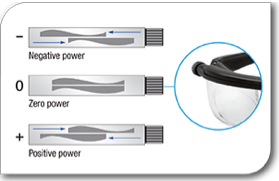
|
Alvarez Lenses
In an Alvarez lens, there are two complex surface lenses that when moved laterally to each other, they change the through power of the total lens.
Emergensee uses the Alvarez lens technology. Each lens comprises two wave-shaped polycarbonate plates that are able to slide across one another. Moving the plates relative to one another can vary the resulting power of each lens.
Emergensee eyewear is intended as a spare pair in case of loss or breakage of the primary pair of glasses. If you have a prescription, especially if it is required for driving, every household should have a pair in the glove box or in the kitchen drawer. I live in earthquake country—seems appropriate to add a pair to my earthquake preparedness kit in my garage, after all. I need glasses for distance and for reading.
JOHN LENNON
Inspired by John Lennon's work, life and iconic look, Adlens created distinctive round shaped glasses. The company sees variable focus lens technology to be consistent with the way that Lennon was a constant advocate for positive, worldwide change and his vision of a better world.
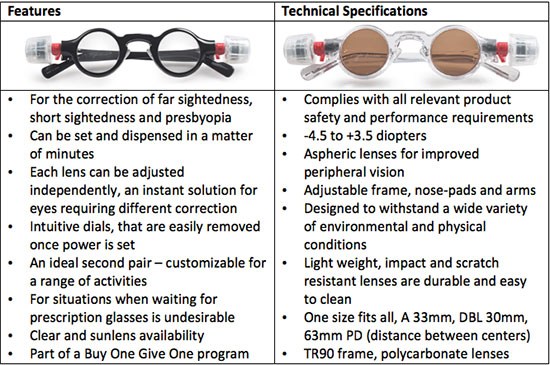
|
HEMISPHERE
Hemisphere is a complete range variable focus of optical and sun eyewear. Customize them for a variety of activities.

|
EMERGENSEE
Emergensee is the solution for lost or broken eyeglasses and contact lenses. Instantly adjustable, variable focus glasses that provide the ideal spare pair for whoever is in need.

|
REPLACE THE DOCTOR?
Last year I showed the Emergensee product during a variety of my lectures when talking about new uses of technology in eyewear. One doctor suggested that consumers would see this as a way to replace the doctor. I don't agree.
Consumers that already see an eyecare professional are taught that their eye exam is an integral part of maintaining good eye and physical health and that the prescription is derived by sophisticated testing. I believe that this consumer would question how variable focus eyewear could replace an actual exam and the prescription derived form it. One does not replace the other.
There are however a lot of Americans that haven't had an eye exam in 5 years or more. Some have never had an eye exam. Many of these consumers try and use readers and have avoided eye exams. If, by trying variable focus eyewear, they see that there is variability between their vision in each eye, they might be encouraged to visit an eye doctor for a comprehensive eye exam as well as a prescription.
OPPORTUNITY
Variable Focus Technology is an opportunity. John Lennon, Hemisphere and Emergensee by Adlens make it possible to change eyeglass lens power by self-adjustment. That delivers minus and/or plus lens power when the wearer or the optician chooses it. This provides a variety of unique opportunities for your office. In fact, look for Variable Focus Technology Part 2 for a discussion of the multiple pair opportunities in your office. For the Adlens
site for more information about Adlens and their products.
|
This content sponsored by Adlens. |



